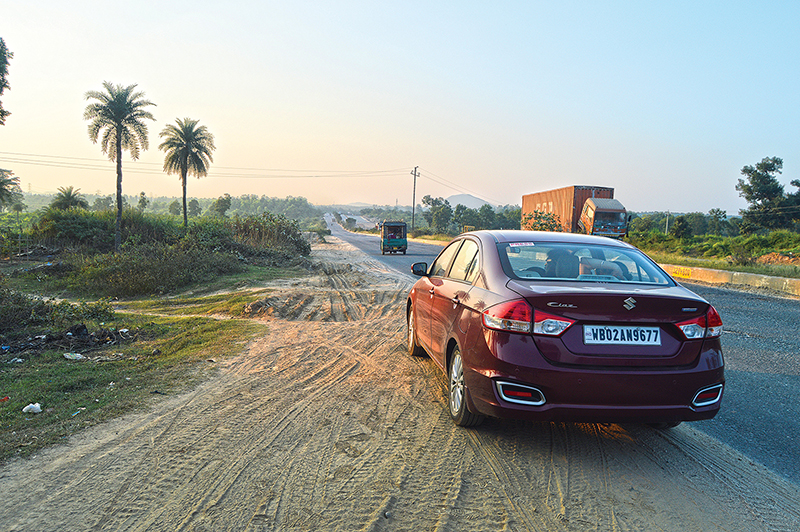
The journey from darkness to light
Tamasoma Jyotirgamaya (lead us from darkness to light) – says the Upanishads. The eternal sunshine of the spotless mind. We strive desparately to find some ‘me-time’ amongst our everyday rush rush routine. Our vacations must thus be carefully chosen to soothe our assaulted senses – with that sense of calm settling down like a billowy cloud to envelop, caress, set free.
Team WHEELS has travelled great distances in the past in search of rare destinations where one can restore sanity to the fevered brow and anxious minds, preferably in the lap of nature. This time it was a slightly different story. For a change, the team wanted to drive out to a place which would be instrumental in fostering that inner search, taking the ‘cure’ one step further. About 480 km from Kolkata, Bodh Gaya in Bihar, a popular tourist destination, was the immediate choice. Yet, though the route was well-travelled, the journey was rather unusual. It was a pilgrimage in search of inner peace – a journey from darkness to light – the journey of life!
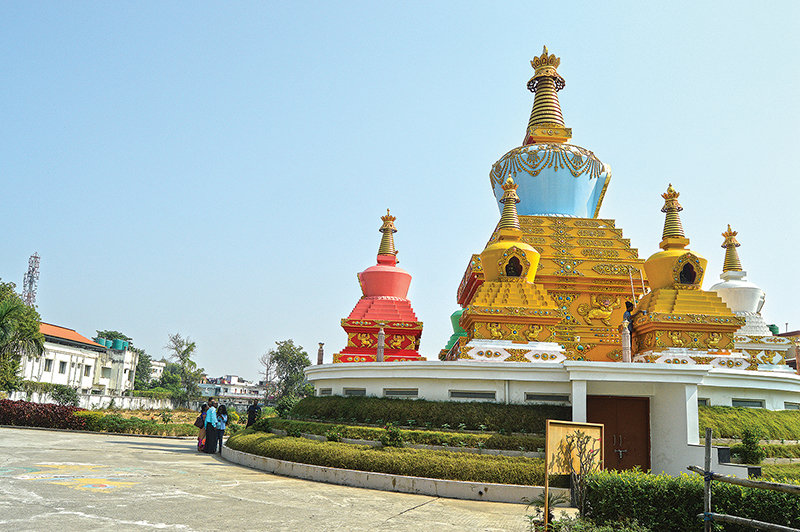
The ornate chorten stupas
Route
Beautiful weather, an energetic team, a swanky sedan – the perfect combination for a long drive! Team WHEELS hit the road at around 8 am, heading for Vidyasagar Setu to enter Kona Expressway and connect to NH-19 (NH-2).
We took a few halts for breakfast and tea and continued, to drive through Bardhaman, followed by Durgapur and Asansol. Thereafter, we followed the NH-19 (NH-2) over Nirsa, Govindpur, Dhanbad, Topchachi, Bagodar, Chouparan to reach Gaya Morh at Dobhi. One would need to take a right below an underpass from Dobhi, leaving NH-19 (NH-2) and proceed straight for another 20 km to reach Bodh Gaya town.
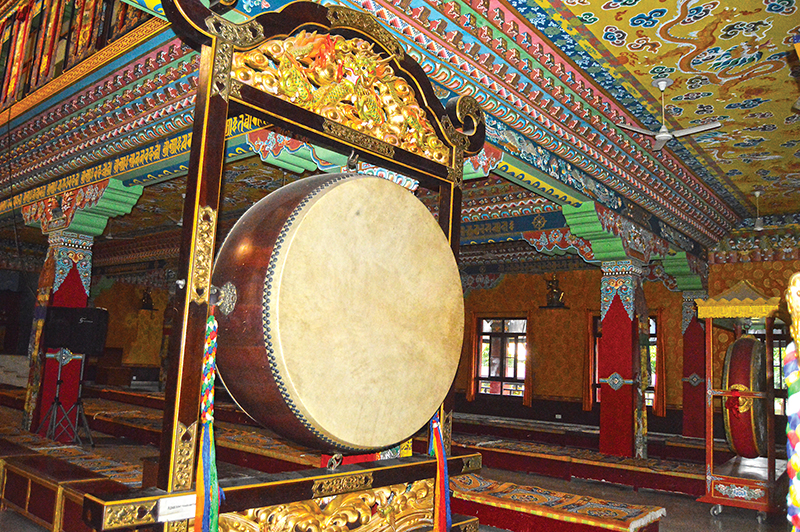 A typical gong – Karmapa Monastery
A typical gong – Karmapa Monastery
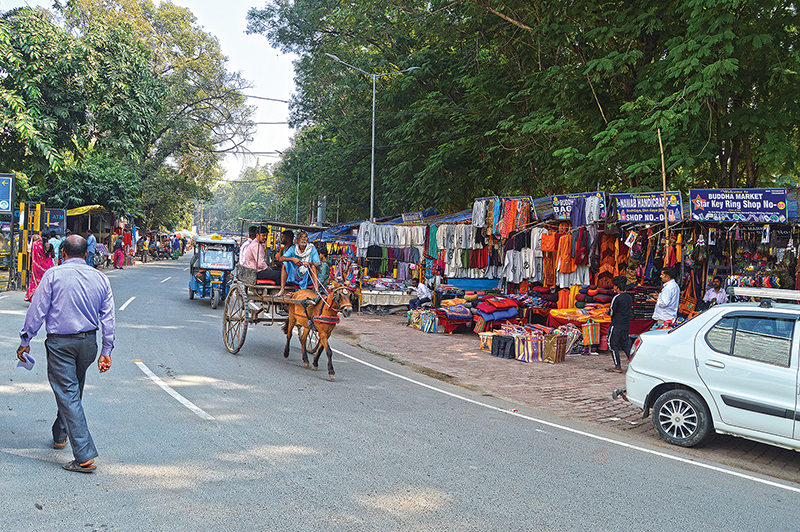
Way to Mahabodhi Temple
Bodh Gaya
We knew we had arrived at our destination when we saw the brightly glowing lights from a distant pagoda. It was 7 pm when we reached the holy town of Bodh Gaya. A warm welcome at the Hotel Oaks with a glass of fresh melon juice quickly rejuvenated us. A 9-hour long drive coupled with a slight dip in the mercury, however, lured us towards rest in the luxurious rooms. Pankaj Chandra, our host at the Hotel Oaks, helped us plan the places to be visited the following day. Later, a lavish buffet dinner including everything from salad to dessert cooked in pan Indian style greeted us at the multi-cuisine restaurant.
Early next morning at the breakfast buffet layout of Café Oaks, apart from the tasty delights, we aso tried the rather bland ‘Okayo’ (a Japanese rice porridge) which tastes better when paired with peanut chutney. Since Gautama Buddha used to have the okayo, it is considered to be a holy food by the Buddhists.
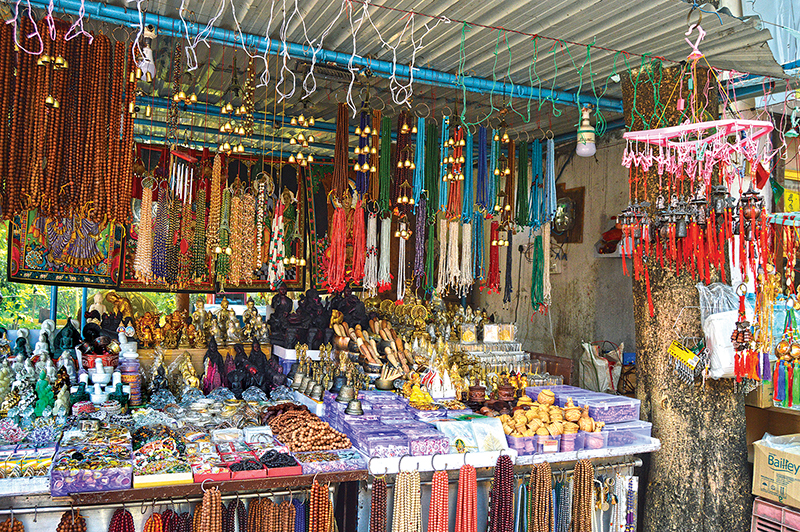
A typical shop selling artefacts and jewellery
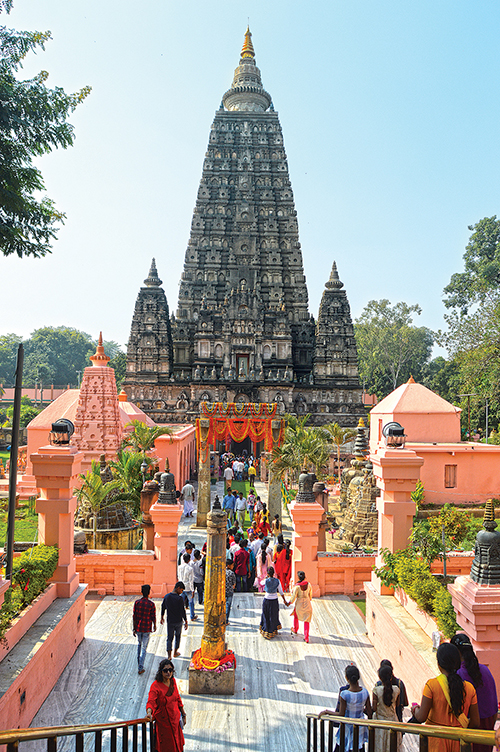
The entrance of the Mahabodhi Temple
Stepping out of our hotel we were fascinated to see the city of monasteries – Bodh Gaya. Of the four pilgrimages, Bodh Gaya is supposed to be the most important one for all the Buddhists across the globe, the other three being Kushinagar, Lumbini, and Sarnath. The city can be seen bursting at the seams with pilgrims from almost all the major Asian countries where the Buddhist population is predominant such as China, Myanmar, Srilanka, Thailand, Vietnam, Tibet, Mongolia and Japan. Tourists from Australia, US and other European countries also flock here.
Inspite of a large number of Indian and foreign tourists at Bodh Gaya, there is very little commotion in the city. There is the relief and complete freedom of anonymity here. Having parked our car in one of the not so busy by-lanes adjacent to the statue complex, we first headed for the city-landmark, the Great Buddha statue.
The Great Buddha Statue
The daunting 80 ft high sculpture of Gautama Buddha inside a walled compound, at the end of a beautifully paved avenue left us wonderstruck. Erected by the Daijokyo Sect of Nagoya, Japan, the Buddha is seen meditating seated on a lotus in Padmasana.
The idol (64 ft high) is a patch-work of blocks of pink chunar sandstone, the lotus (6 ft high) of yellow chunar sandstone and the pedestal (10 ft high) of red granite stone. On either side of the Buddha are the statuettes of his ten chief disciples. Designed by the noted sculptor, Shri Ganpathy Sathpathy of Chennai, the statue was unveiled by the great Dalai Lama on 18 November 1989.
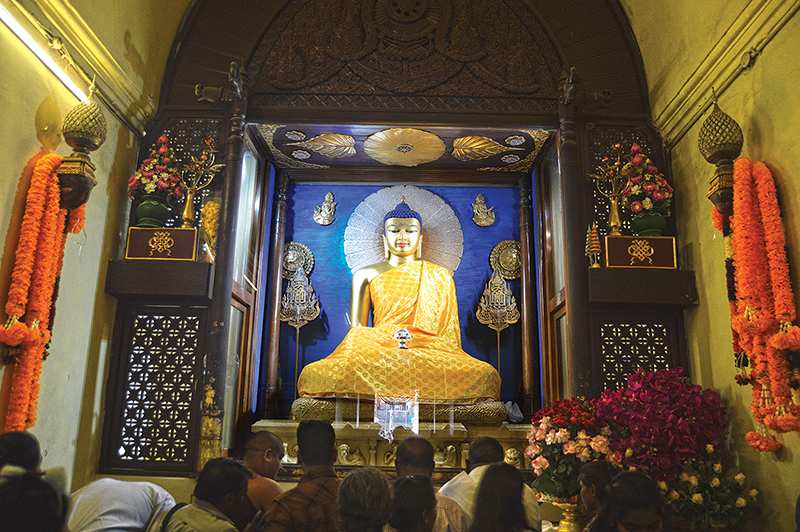
The glorious shrine – Mahabodhi Temple
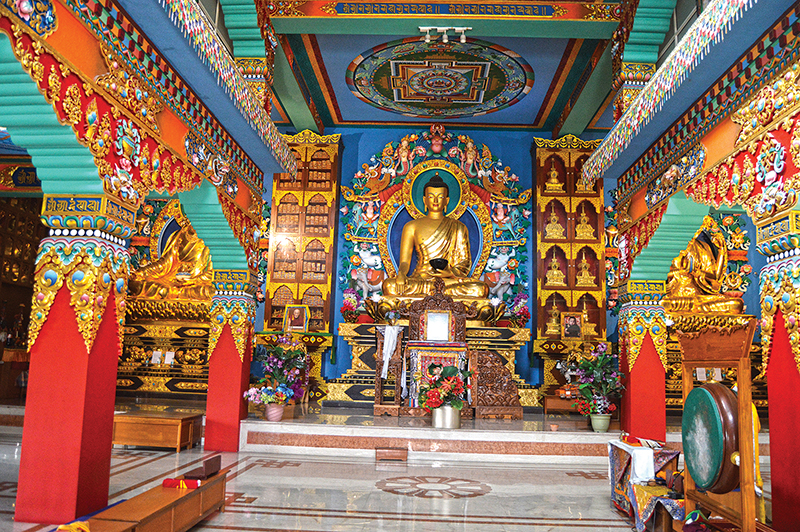
Palyul Namdroling Monastery
Spread across 4.5 acres of land, Palyul Namdroling is probably the largest monastery in Bodh Gaya. On entering through the gate, the beautifully coloured and highly ornamental chorten (crown shaped) stupas captivated us.
We walked down the broad pathway with manicured grass lawns on either side and reached the magnificent temple built in the Tibetan style. The dazzling colours and paintings on the walls and ceiling left us spell bound. In Buddhism, each of the colours signifies certain attributes of life. We carefully observed and silently admired the delicate paintings representing various facets of human life.
Peace emanates from every inch of the dimly lit, colourful temple. High up on the walls are small statuettes of a thousand golden Buddhas representing his thousand avatars. These brass statues were glowing in the dim light.
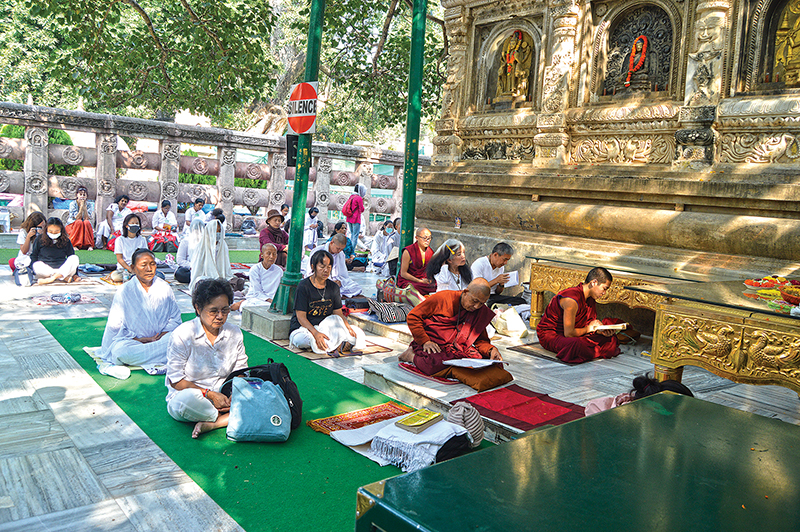
The pilgrims in meditation in front of the diamond throne – Mahabodhi Temple
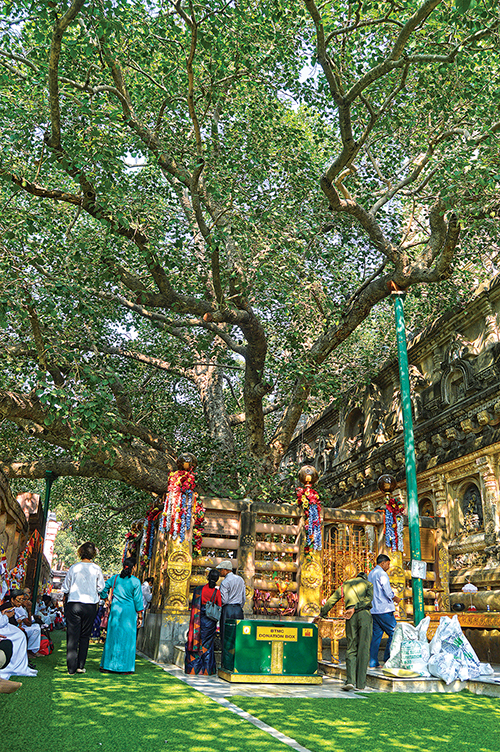
The sacred Bodhi Tree
We saw Rincsen Lama, a Buddhist student and a monk in his 6th year arrange the offerings of the Lord on the mandelas (praying spaces). We stood in silence, folded arms before the three huge golden idols – Guru Padmasambhava on the left, Avalokiteswara on the right and Gautama Buddha in the middle. A strange calm engulfed us.
Driven by and on a sort of spiritual quest we set off for the major attraction of Bodh Gaya, the Mahabodhi Temple. As private cars are not allowed within a 1 km radius of the temple, we left our car at the main parking lot of the city on Dumuhan-Bodh Gaya Marg and hired a toto. Enroute, we were captivated by the sight of the gorgeous monasteries of different countries each marked by its signature style.
Wat Thai Temple
Considered one of the most beautiful monasteries in Bodh Gaya, we marveled at the large ashtadhatu statue of the Buddha. Meditation classes are held here in the morning and evening. The monastery also has a guest house for the pilgrims.
The Chinese Monastery
This is one of the oldest monasteries built in the traditional Chinese style. The monastery has three elegantly carved Buddha statues. Probably no other city in the world has such a large number of Buddhist temples and monasteries as Bodh Gaya.
On our way to the Mahabodhi Temple, we stopped to see the Burmese Vihara, the Vietnam Temple, the Royal Bhutanese Monastery, the Japanese Temple and the Bodhiraja Monastery.
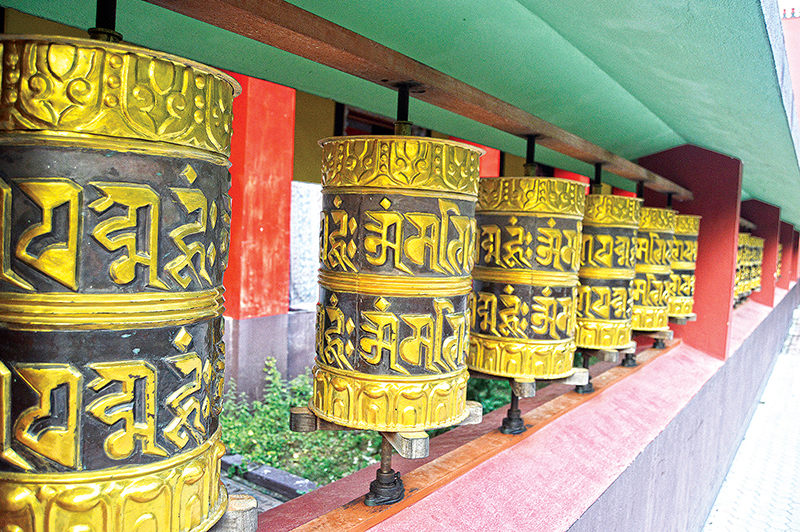
The low humming chokhors
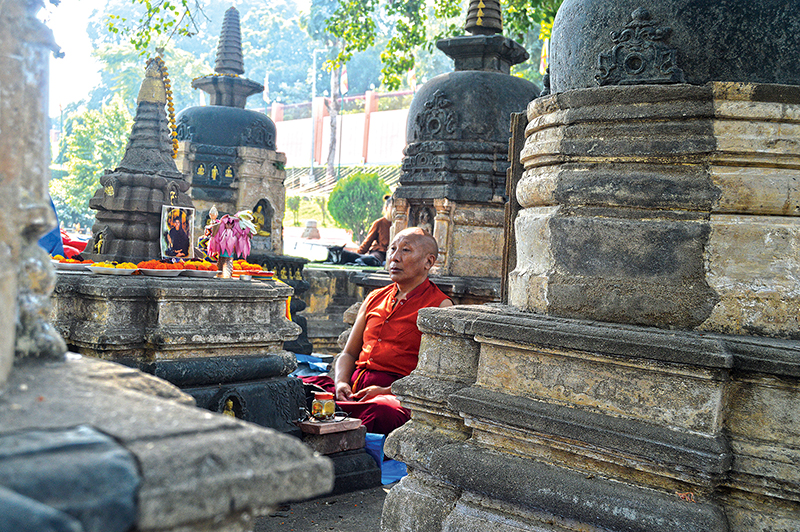
The monks in meditation amidst the stupas
The Mahabodhi Temple
We enjoyed window shopping at some of the most amazing shops selling myriad items, on either side of the road leading to the Mahabodhi Temple. Here you can discover untold gems – chic, stylish apparels, statues, incense, shawls, paintings and Tibetan artefacts, jewellery and semi-precious stones. Some of the finds are incredible bargains.
The Temple complex swarms with hawkers and vendors. A series of booths have been set up in front of the Temple gate for you to leave behind your footwear and electronic gadgets at, free of cost. Photography is allowed for a fee.
The city being the seat of Buddhism in the country, welcomes a large number of foreign tourists round the year. But surprisingly, one can move about freely without any restrictions imposed by the monks or monastery authorities or having to face the irritation of agents out to make a quick buck, a common practice in most other pilgrimage spots. The innumerable monasteries and temples that dot the landscape also do not charge any entry fee.
We gradually walked amidst tight security towards the entrance of the Mahabodhi Temple. From this vantage point, the temple looks splendid. The main shikhara (or tower) of the Temple is over 55 m (180 ft) high and is beautifully carved.
History
It is said that around 589 BC Siddhartha Gautama, a young prince who was deeply affected by the suffering of his people, sat in meditation under a peepul tree. This later became known as the Bodhi tree. It is in that location that Emperor Ashoka built the Mahabodhi Temple in around 260 BC.
Gautama Buddha spent seven consecutive weeks meditating and considering his experiences. At the end of 49 days, Buddha attained Nirvana. He spent the first week under this Bodhi tree.
Descending the stairs, we entered the temple with many other pilgrims and devotees. We were amazed at the luminosity of the bright yellow shrine of the Buddha with its golden accessories and large glittering halo behind the idol. We bowed in veneration and prayed quietly for a few minutes.
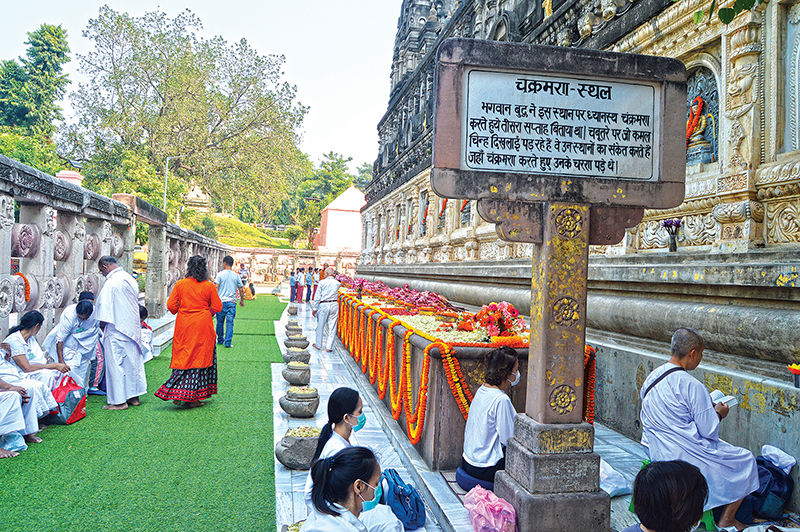
The area of the Buddhas cloister walk
The Bodhi Tree
Right behind the Temple is the sacred Bodhi Tree, which may not be the one that provided shade to the Buddha 2,500 years ago, but may well be a direct descendant.
We saw the Bodhi Pallanka – the place where the Buddha attained Enlightenment in 623 BC sitting under the peepul tree. It is here that Emperor Ashoka had supposedly placed the Vajrasana (diamond throne) somewhere between 250-233 BC. Pilgrims from all over the world come to offer prayers and meditate in front of the diamond throne.
The Temple premises is paved with marble. Devotees are seen sitting and meditating and chanting hymns. Some practice meditation on the walk. The path the Buddha walked after his enlightenment is marked as the Cankamana (cloister walk). This is how the Buddha had spent his third week – walking up and down in meditation. The platform is decorated with floral garlands and lotuses indicating the place of his occasional rests during his walks.
An open arena outside the compound of the Temple is an altogether different world. Here, under the peepul tree were laid several mats. A large group of Vietnamese pilgrims were seen distributing the Tripitakas (the holy book of the Buddhists) to the devotees. Some were also seen chanting the hymns.

The sprawling campus – Palyul Namdroling Monastery
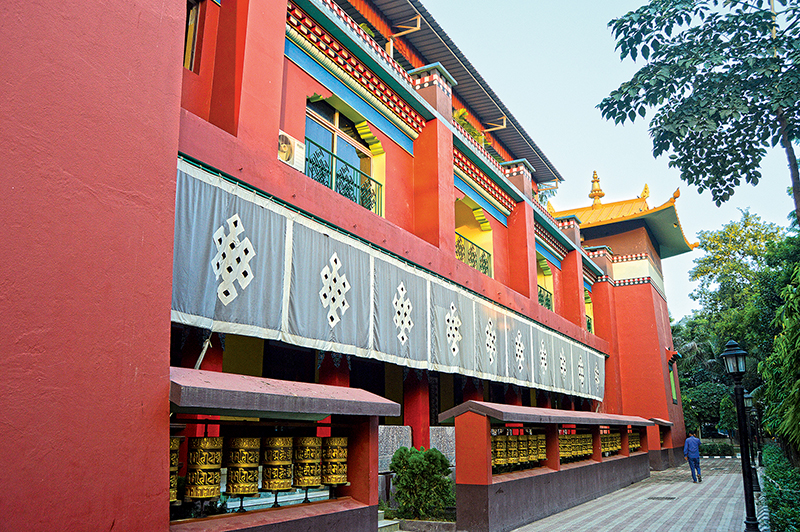
The resplendant Karmapa Monastery
Boon, a Thai monk, who is a regular visitor at Bodh Gaya told us that the International Tripitaka Chanting Festival is held every year between December 2 and 12 where the Tripitakas in English are distributed for free. We were surprised to learn that the number of volumes in the Tripitakas vary among countries. While Vietnam has as many as 49, Myanmar has only 29 volumes of the Tripitaka. Even more astounding is that some of the monks manage to memorise all the volumes.
The open arena abounds in stupas of various shapes and sizes. Monks from Myanmar, Tibet, Thailand, Vietnam, China and Mongolia sat in meditation in front of each stupa. We had the privilege of being able to converse with some of them and learning about their lives. Kylie, an Australian tourist, is so enamoured of the city that she comes to Bodh Gaya almost every year to meet her nun-friend.
We sat soaking in the spiritual silence. And as we, in meditation, tried to accumulate the life force within the spherical spiritual eye, we completely lost track of time and space. Had it not been for the sound of the azaan by a maulavi from a mosque adjacent to the Temple complex, we might have remained thus motionless for goodness knows how long. We felt as if in a state of trance difficult to describe in words. A leaf falling off the sacred tree marked the end of our meditation – probably a blessing from the Lord. One of us picked it up to treasure and keep.
We went back to Hotel Oaks for lunch. It was past 3, the buffet was over. We quickly had some soup and pasta and rushed out to visit the next set of monasteries before it became too dark.
Metta Buddharam Temple
You can’t miss out on this new Thai temple with its huge meditating Buddha, carved in stark white. The temple looks striking because of its white and charcoal black combination embellished with glass-mosaic. The mosaic work glows and glitters, the gleaming facets flirting with the sunlight which merely touches to set every hidden pore afire.
On the right side of the entrance is the statue of Indra Dev and on the left that of Emperor Ashoka. A giant bell hangs on the right side of the gate.
As the sunlight turned dim, we hurried to our final destination of the city, without which our tour would remain incomplete – the Karmapa Monastery.
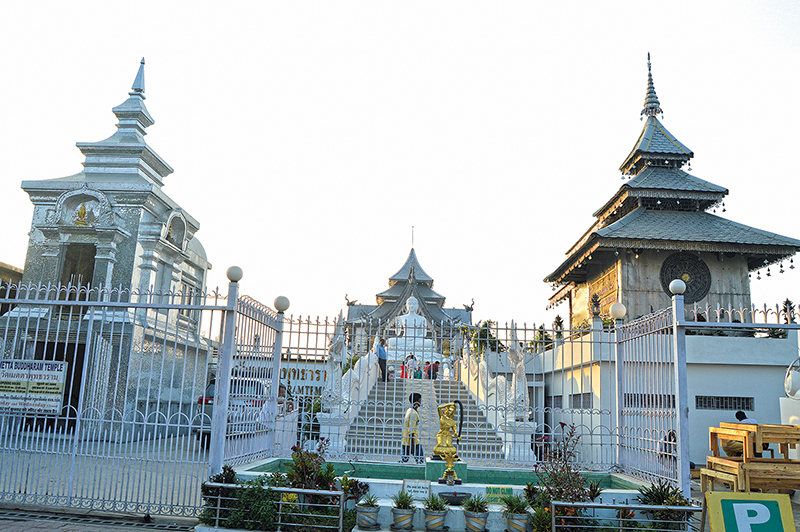
The captivating Metta Buddharam Temple
Karmapa Monastery
Visiting the Karmapa Monastery was indeed a memorable experience. Here children are taught the tenets of Buddhism from a tender age. The main gate of the monastery is closed to the public, so one has to enter from the side.
Inside, a rather mysterious looking double storeyed building in a very interesting array of colours of brick red, white, blue, black and yellow, intrigued us. This is the only monastery with a series of chokhors (prayer spindles). We could not resist spinning the chokhors in succession. The low humming that accompanied the spinning seemed to come from the depths of the earth and rise to meet the untrammeled blues above.
And as we entered the prayer hall, we stopped awestruck at the beautiful paintings on the walls. We stared in silence at the grand statue of the Buddha (current avatar) in the middle, with his previous avatar on the left and his next avatar on the right. It was almost time for prayer.
As the evening descended, the gong was sounded, the junior monks and children took their seats in front of the low-desks arranged in rows. The many-hued walls, the well-lit prayer hall, the fragrance of the incense, the gorgeous decorations, the monks seated before the shrine and their holy chants in unison at the twilight hour – it was as if the monastery had cast a magic spell on us. A peculiar heaviness had settled in the very air we breathed, our limbs felt lifeless and weighted down. Yet we had to leave and as we crossed the gate, the air was filled with the mystic chant ‘Buddham -Sharanam- Gachhami’.
Accommodation
Located in the heart of the city on the Gaya-Rajgir Highway, Oaks Bodhgaya is an excellent base for visitors aiming to attain Nirvana in retrospect – by ‘discovering’ the city’s sacred Buddhist heritage. Belonging to the Minor Hotel Group, Bangkok – Hotel Oaks, Bodhgaya is a star-rated property which was opened under the FDI programme in India.
The hotel has an enormous lobby-lounge, a lavish feel. This plush, 78-room property provides guests with the flexibility of three different room types, including twin-share, king and inter-connecting suites. The rooms are tailor-made for both the solo traveller as well as well-heeled families.
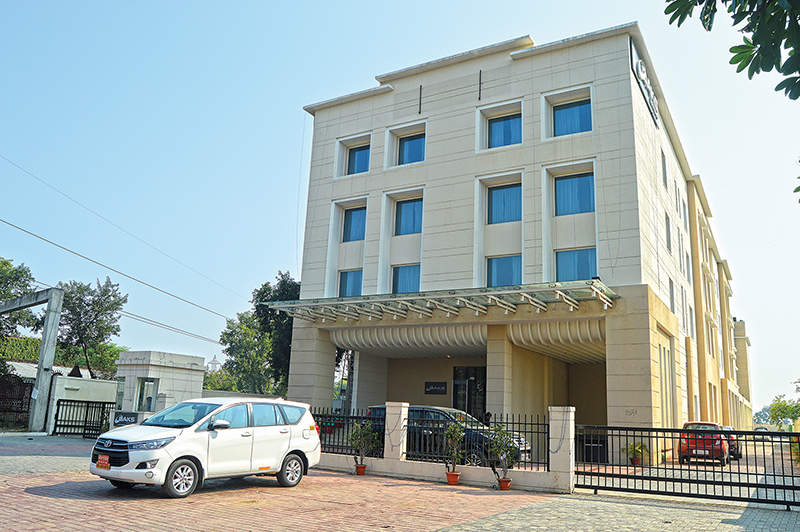
The facade – Hotel Oaks Bodhgaya

The sprawling multi-cuisine restaurant – Hotel Oaks Bodhgaya

A luxurious guest room – Hotel Oaks Bodhgaya

An exquisite suite – Hotel Oaks Bodhgaya
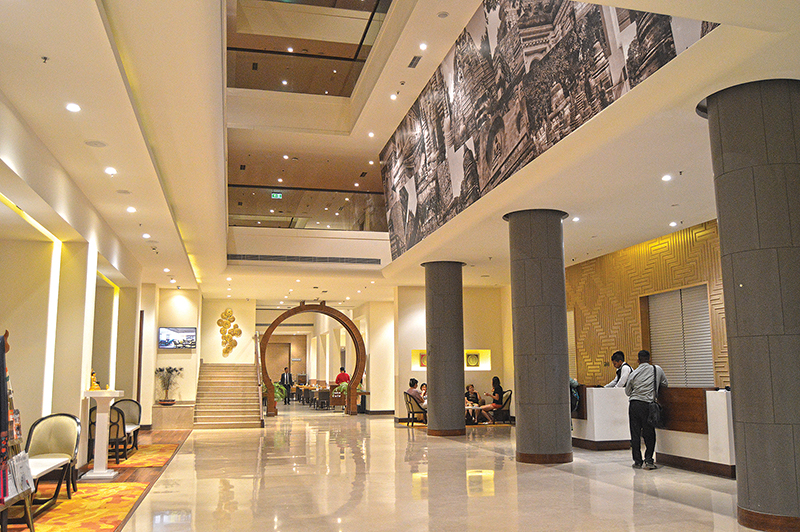
The lavish lounge – Hotel Oaks
At Oaks Café, the 70-seater multi-cuisine restaurant, you can enjoy the convenience of all-day dining. Bodhy Lounge, the lush landscaped terrace, is the major attraction of the hotel. Here you can imbibe some local wisdom on the road to enlightenment in the Bodhi meditation zone or work out at the fitness room and hope for liberation from samsara, the painful cycle of rebirth.
The hotel is ideal for conferences and business gatherings. The banquets have a capacity of 120 each. The open lobby lawn has a capacity of 1500 and is a fantastic venue to plan weddings at. There is a vast parking space available at the periphery of the hotel which can accommodate up to a 100 cars.
Early next morning we set off on another journey – the journey ‘back to the future’! From the seat of spiritualism we perforce had to head back towards the drudgery of our daily existence. In our hearts, though, we carried a secret. It was all intact, nothing was gone! What we had experienced at Bodh Gaya would stay with us until it had taught us all we need to know. In spirituality the self has to be realised! Bodh Gaya had awakened the first stirrings of bodh or awareness in us. From here onwards, we would have the blessing of unassailable faith hovering, like a soft warm light, overhead, or wrapped around us, like a cocoon designed to envelop us in safety forever.

Standard : B+

Standard : A+
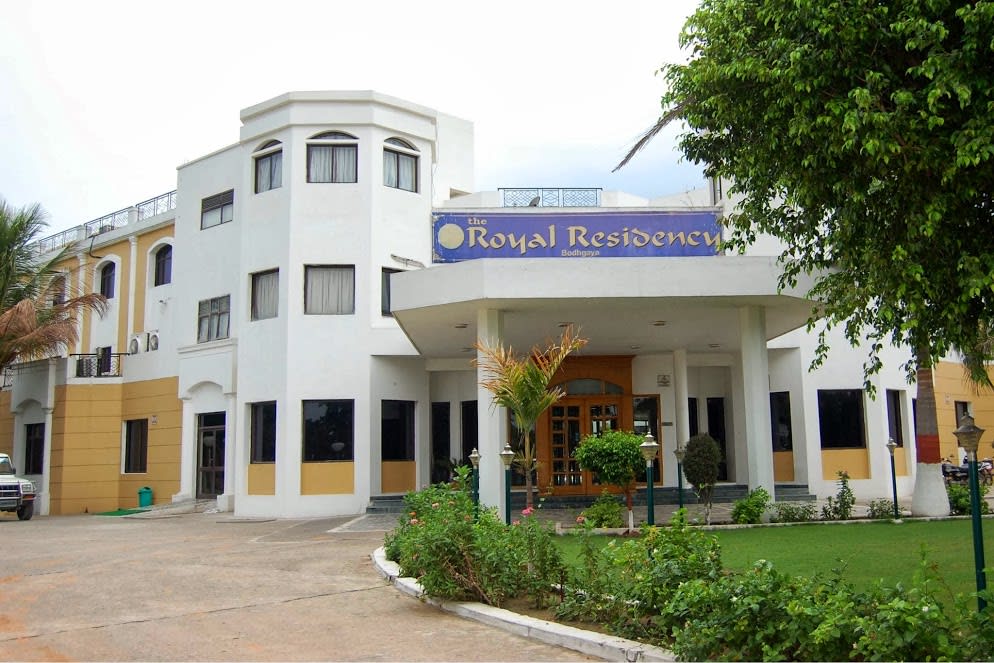
Standard : A